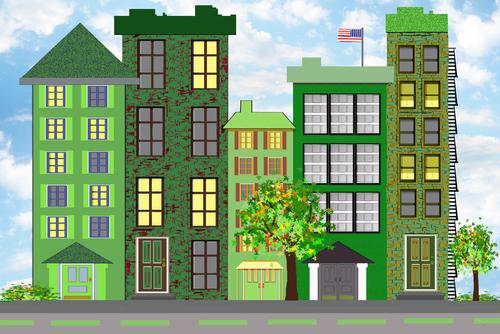How to measure the ROI of LEED
<p>Measuring the costs and benefits of LEED certification is easier now that multiple studies have shown green buildings sell for higher prices and draw higher rents. </p>

green city block
Editor's Note: To learn more about the financial implications of LEED buildings, be sure to check out VERGE@Greenbuild, November 12-13.
Owners considering LEED certification for their buildings often ask what level of financial return they can expect for their investment in green products and services.
This starts with a measurement of costs. Owners should be certain their LEED consultant is able to audit their buildings and accurately calculate the cost of obtaining various levels of LEED, including both the implementation of improvements and the cost of the certification process itself.
Estimating the financial gain is a trickier process, as market variables and qualitative benefits enter the equation. But the challenge of calculating return on investment (ROI) is lessened somewhat by the steady stream of reports analyzing the cost of LEED in new and existing buildings -- and the financial payback.
The cost of LEED
The most commonly cited studies on the incremental cost of LEED come from international construction company Davis Langdon, which compared fit-outs and renovations in LEED and non-LEED buildings. Overall, fit-outs and renovations of LEED-certified buildings carried a premium of 1.84 percent, or slightly more than $18,400 per $1 million of construction cost. The incremental cost averaged 2.11 percent in LEED Silver buildings, and just 1.82 percent in LEED Gold buildings.
Why would Silver certification cost more than Gold? Davis Langdon theorized that some owners pursuing Silver certification may have implemented expensive technology, while those reaching for Gold may have taken greater advantage of passive design opportunities.
The Design-Build Institute of America found that integrated project delivery methods -- including those that involve a project or construction manager -- are more successful overall than traditional design-bid-build methods at achieving or exceeding anticipated LEED levels. In Jones Lang LaSalle’s experience as project and construction managers, we’ve also seen that a collaborative process that results in a greener building results in a better-performing building overall, at less cost and in less time than traditional development.
For new buildings, a collaborative approach to green development can achieve LEED compliance while costing less than a similar non-LEED building using a less-efficient method. Retrofits offer fewer opportunities to use passive design and collaborative construction, but these approaches can still mitigate the incremental cost of LEED.
Financial Benefits of LEED
There is no one-size-fits-all way to estimate the value LEED certification will bring to a given building. The first consideration is whether the building is owner-occupied, such as a corporate headquarters campus, or leased to many tenants, as most downtown high-rises are.
For a large corporate occupier, the short- and long-term payback from lowered utility costs alone will typically exceed any construction surcharge to meet LEED standards.The average energy savings for
Energy reduction opportunities are just as great in multi-tenant buildings, but cost savings do not always translate into simple payback for investor owners. That's mainly because office leases typically pass through operating costs to tenants on a pro rata basis, so an owner who invests in capital projects to improve energy efficiency often can’t recapture the cost via energy savings. Tenants on short-term leases can’t be expected to pay for major capital projects, and tenants who promote efficiency with strategies such as buying ENERGY
This misalignment of cost and benefit in multi-tenant buildings means that instead of trying to recapture their investment through direct payback, most owners view energy efficiency as a way to increase rent and occupancy.
A large percentage of tenants look for buildings with LEED certification when considering relocation or renewal. In a 2010 survey by CoreNet Global and Jones Lang LaSalle, 23 percent of corporate real estate decision-makers said sustainability was a “major factor” in lease decisions, and an additional 18 percent called it a “tie-breaker” between buildings of equal price and quality. Only 8 percent said sustainability was not a factor in their location decisions.
Research shows green buildings are worth more than comparable buildings. One study reported an average 11 percent premium on the sale of LEED certified office buildings, and another found LEED buildings typically attracted 15 to 18 percent higher rent than comparable buildings. The upshot: The increase in building value exceeds the nominal cost for LEED certification.
Impact on Productivity
While investor-owners tend to focus on the direct payback, corporate real estate directors are driven by different criteria altogether. Owner-occupied buildings don’t look at rent or property values as measures of effectiveness. Instead, they consider ways to measure employee productivity and engagement arising from sustainability strategies.
LEED-designed work spaces are more comfortable in terms of temperature and air quality. While most people feel that comfortable employees are more productive ones, until recently such productiveness was considered a “soft” benefit. Today, however, there are tools to help tenants compare buildings in terms of the potential for employee productivity improvement and retention. In essence, companies are starting to quantify the impact of office space on productivity.
Using a formula based on research data measuring before-and-after effects of sustainable improvements on employee behavior, real estate professionals can measure the cost of LEED against the benefits in human capital. Studies that feed data into the formula have found:
- Office building-related illnesses cause $60 billion in lost productivity every year.
- Increasing daylight levels raised overall productivity by 13 percent and improved mental function and memory recall by 10 to 25 percent.
- Workplaces with good air quality and ventilation showed productivity increases of 1 to 9 percent, and gains of 3 to 11 percent correlating to temperature control.
One such analysis showed that sustainable space added value equivalent to $32.50 per square foot through an estimated 5 percent gain in worker productivity in a more comfortable environment, as well as $16.50 per square foot in reduced expenses associated with lower staff turnover and absenteeism due to a healthier and more enjoyable workplace.
The combined $49 per-square-foot benefit nearly offset the $60 per-square-foot occupancy cost.
Executives at all levels increasingly recognize there are strong organizational benefits to be derived from LEED-compliant practices. As tools to quantify those benefits continue to improve, real estate and facilities professionals are having an easier time justifying the minimal expense of LEED certification.
Whether the measurement is in terms of direct energy payback, increased cash flow from properties or an improved environment for employee productivity, the ROI of LEED is indisputable.
Image of green city block provided by Dustie available through Shutterstock.
